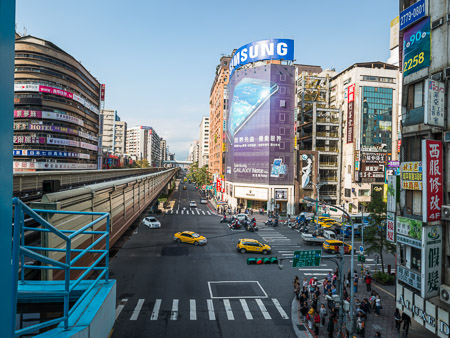Getting To & Getting Around Taipei

The elevated metro line that opened in 2017 cut travel time between Taoyuan International Airport and central Taipei to just 35 minutes for express services (ordinary services take 50 minutes). However, for visitors with lots of luggage or who plan to stay some distance from Taipei Main Station, a taxi may well be more convenient. Of course, if you’ve booked a Life of Taiwan guided tour of the island, you can arrange for your driver-guide to pick up directly from the airport and begin your exploration of Taiwan without delay!
Taipei Metro trains zip across the capital, taking just 12 minutes between the Sun Yat-sen Memorial Hall and Ximen (the station for Ximending). One of the longest journeys is Tamsui to Taipei Main Station, which takes 38 minutes and costs just under US$2. The six metro lines and 117 stations are supplemented by a very comprehensive bus network on which journeys seldom cost more than US$1. Like the metro, Taipei’s buses feature multilingual signs and announcements, making life easy for foreign visitors.
A few words of warning: Many metro station exits have neither lifts nor escalators, so be prepared to climb quite a few stairs. And during peak travel periods, both the metro and the city bus system tend to get very crowded. Don’t be surprised if you have to stand up for the entire journey — or consider taking one of the ubiquitous yellow taxis. These can be waved down almost everywhere and few taxi rides cost more than US$10. Unlike in some other Asian cities, Taipei taxi drivers don’t expect to be paid a peak-travel premium, nor do they expect to be tipped. Few drivers speak much English but all are honest; meters are always used unless the destination is really out of the way. Because of the language barrier, some travellers prefer to use Uber; the app allows you to request a ride and see a fare estimate before you commit yourself. During rush hours you may end up paying more than if you take a conventional taxi, however. Grab, which is very popular in Southeast Asia, doesn’t operate in Taiwan.
Taipei enjoys excellent bus and train connections with other cities in north Taiwan, and there are direct bus services to tourist magnets like Yehliu and Jiufen. The historic port city of Keelung is seldom more than 50 minutes away by conventional train, while getting to Hsinchu takes just over half an hour on the High-Speed Railway (HSR). Thanks to Freeway 5 and one of the world’s longest road tunnels (a 12.9 km / 8 mile-long burrowing through the Central Mountain Range), getting to Yilan in the northeast seldom takes much more than an hour. Throughout Taiwan, public transport is very reasonably priced: A conventional express from Taipei to Hsinchu, for instance, never costs more than US$6 one way.
Coming up from the south
Reaching Taipei from the south of the island can be done by train, bus, or car. Those making use of Taiwan’s efficient freeway (motorway) network can get to the capital in about four hours from Tainan, or five hours if they’re starting from Kaohsiung. Taichung is around two hours away. On long distance runs, conventional trains are a little slower than express buses as well as a bit more expensive. The HSR is a better option for those in a hurry. By bullet train, Kaohsiung to Taipei takes as little as 1 hour 45 minutes, but costs up to US$49 one way.
